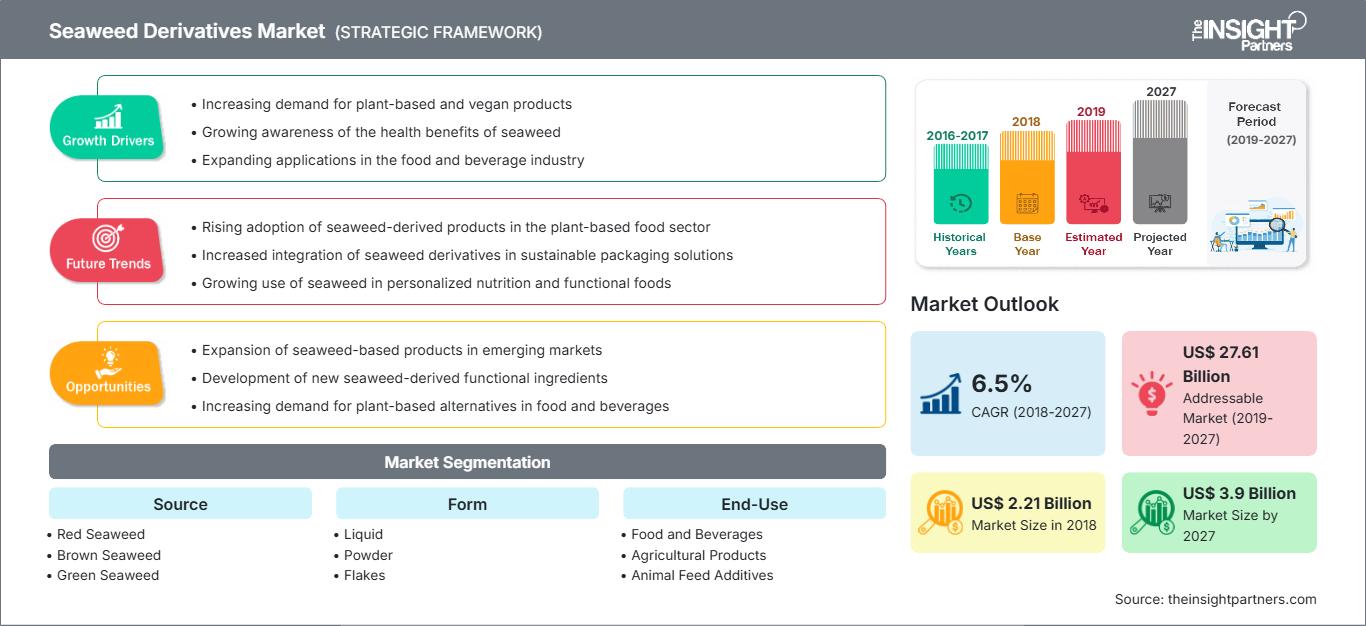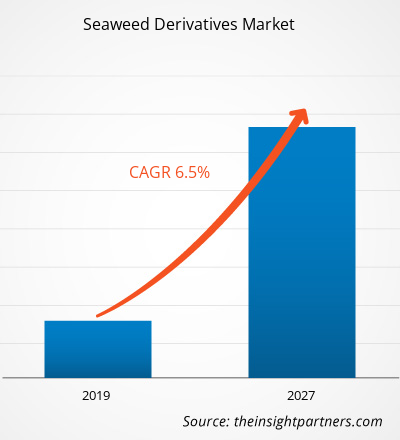Der Markt für Algenderivate wurde 2018 auf 2.210,35 Mio. USD geschätzt und soll bis 2027 3.903,91 Mio. USD erreichen; von 2019 bis 2027 wird ein durchschnittliches jährliches Wachstum von 6,5 % erwartet.
Algen sind im Wesentlichen rote, braune und grüne Meeresmikroalgen, deren Extrakte aufgrund ihrer wachstumsfördernden Wirkung im Gartenbau verwendet werden. Zu den chemischen Derivaten von Algen gehören unter anderem Fettsäuren und Vitamine, Mineralstoffe, Phytoharmonien und komplexe Polysaccharide. Zu den wichtigsten Algenderivaten gehören Alginate, Carrageene und Agar-Agare. Alginate werden größtenteils aus Braunalgen gewonnen, während Carrageene und Agar-Agare größtenteils aus Rotalgen gewonnen werden. Alginate, Carrageene und Agare finden zunehmend Verwendung in der Lebensmittel- und Getränkeindustrie, der Tierfutterindustrie und der Landwirtschaft.
Im Jahr 2018 hatte der asiatisch-pazifische Raum den größten Anteil am globalen Markt für Algenderivate, gefolgt von Europa und Nordamerika. Die steigende Nachfrage aus der Lebensmittel- und Getränkeindustrie, der Tierfutterindustrie und der Landwirtschaft treibt den Markt im asiatisch-pazifischen Raum maßgeblich an. China, Südkorea und Japan sind die größten Produzenten und Verbraucher von Algenderivaten im asiatisch-pazifischen Raum. Der Markt wird maßgeblich durch die breitere Anwendung von Algenderivaten in der Lebensmittel- und Getränkeindustrie angetrieben. Sie werden zunehmend in Düngemitteln eingesetzt, was den Ernteertrag verbessert und die Pflanzen kräftiger macht, was wiederum die Schädlingsresistenz fördert. Das steigende Bewusstsein der Verbraucher hinsichtlich der gesundheitlichen Vorteile von Algenderivaten beflügelt den Algenmarkt erheblich. Auch die steigende Nachfrage nach Bio-Lebensmitteln treibt das Wachstum des Marktes für Algenderivate voran. Das geringere Bewusstsein der Landwirte für die Gewinnung von Seetang hemmt das Marktwachstum für Seetangderivate.
Der COVID-19-Ausbruch begann im Dezember 2019 in Wuhan (China) und hat sich seitdem rasant über den Globus verbreitet. China, Italien, Iran, Spanien, die Republik Korea, Frankreich, Deutschland und die USA gehörten im Hinblick auf die Zahl der positiv Getesteten und gemeldeten Todesfälle (Stand: März 2020) zu den am stärksten betroffenen Ländern. Der COVID-19-Ausbruch hat aufgrund von Lockdowns, Reiseverboten und Geschäftsschließungen die Wirtschaft und Industrie in zahlreichen Ländern beeinträchtigt. Die globale Lebensmittel- und Getränkeindustrie ist einer der wichtigsten Wirtschaftszweige, die infolge dieses Ausbruchs unter schweren Störungen wie Unterbrechungen der Lieferkette, Absagen von Technologieveranstaltungen und Büroschließungen leidet. China beispielsweise ist das globale Zentrum der Produktion und der größte Rohstofflieferant für zahlreiche Branchen. Der allgemeine Markteinbruch aufgrund von COVID-19 beeinträchtigt auch das Marktwachstum für Seetangderivate aufgrund von Fabrikschließungen, Hindernissen in der Lieferkette und einem Abschwung der Weltwirtschaft.
Passen Sie diesen Bericht Ihren Anforderungen an
Sie erhalten kostenlos Anpassungen an jedem Bericht, einschließlich Teilen dieses Berichts oder einer Analyse auf Länderebene, eines Excel-Datenpakets sowie tolle Angebote und Rabatte für Start-ups und Universitäten.
Markt für Algenderivate: Strategische Einblicke

-
Holen Sie sich die wichtigsten Markttrends aus diesem Bericht.Dieses KOSTENLOSE Beispiel umfasst Datenanalysen, die von Markttrends bis hin zu Schätzungen und Prognosen reichen.
Markteinblicke
Die steigende Nachfrage aus der Lebensmittel- und Getränkeindustrie hat den Markt für Algenderivate weltweit begünstigt.
Algenderivate wie Agar, Alginate und Carrageene werden in großem Umfang in verschiedenen Lebensmitteln und Getränken verwendet. Diese Derivate kommen in einer Vielzahl von Lebensmitteln und Getränken zum Einsatz, beispielsweise in Eiscreme, Sirup, Aufschnitt, Babynahrung, Mandelmilch, Schlagsahne, Schokoriegeln, Schokoladenmilch, Kaffeegetränken (z. B. Eiskaffee und Kaffeegetränken auf Sojabasis), Kaffeeweißer, Ricotta, Joghurt, Hüttenkäse und Sauerrahm. Carrageene werden als Verdickungsmittel in Puddings, Schokoladenmilch, Kaugummi, Marmelade und Gelees verwendet. Darüber hinaus reduzieren Carrageene die Abfallmenge, indem sie die Haltbarkeit von Lebensmitteln ohne Qualitätsverlust verlängern. Verschiedene Lebensmittel wie Mayonnaise und Salatdressing würden sich ohne die Hilfe eines Stabilisators trennen. Daher wird Carrageen als Stabilisierungsmittel in Mayonnaise und Salatdressing verwendet. Daher fördert ein breites Anwendungsspektrum von Algenderivaten in der Lebensmittel- und Getränkeindustrie das Wachstum des Marktes für Algenderivate weltweit.
Quelleninformationen
Basierend auf der Quelle ist der Markt für Algenderivate in Rotalgen, Braunalgen und Grünalgen segmentiert. Im Jahr 2018 hatte das Rotalgensegment den größten Anteil am weltweiten Markt für Algenderivate. Rotalgen neigen dazu, den höchsten Proteingehalt zu besitzen, der für ihre rote Farbe verantwortlich ist. Obwohl Rotalgen in flachen Gewässern vorkommen, können sie auch tiefem Wasser und schlechten Lichtverhältnissen standhalten. Diese Faktoren fördern das Wachstum des Marktes für Rotalgenderivate.
FormInsights
Basierend auf der Form ist der Markt für Algenderivate in Flüssigkeiten, Pulver und Flocken unterteilt. Im Jahr 2018 machte das flüssige Segment den größten Anteil des globalen Marktes für Algenderivate aus; es wird jedoch erwartet, dass das Pulversegment im Prognosezeitraum die schnellste Wachstumsrate verzeichnet. Flüssige Derivate aus Braunalgen werden für den Einsatz im Gartenbau und in der Landwirtschaft vermarktet. Die flüssigen Algenderivate werden in hohen Verdünnungsraten verwendet, was zu minimalen Materialmengen auf der jeweiligen Fläche führt. Die Wirkstoffe in flüssigen Algenderivaten können solch niedrige Temperaturen beeinflussen.
Einblicke in die Endverwendung
Basierend auf der Endverwendung ist der Markt für Algenderivate in Lebensmittel und Getränke, Agrarprodukte, Futtermittelzusätze, Pharmazeutika und Sonstiges unterteilt. Im Jahr 2018 hatte das Segment Lebensmittel und Getränke den größten Anteil am globalen Markt für Algenderivate; es wird jedoch erwartet, dass das Segment Futtermittelzusätze im Prognosezeitraum die höchste Wachstumsrate verzeichnet. Algenderivate wie Alginate werden häufig in Backwaren, Süßigkeiten, Milchprodukten, Salatdressings, Eiscreme, Cremes und Gelees sowie in Wurst, Fleischverarbeitung und Fisch verwendet. Sie werden auch zur Klärung von Bier und Wein verwendet. Alginate sind vollständig organisch und lebensmittelecht. Darüber hinaus können Alginate eine Lösung verdicken, wenn sie in Wasser aufgelöst werden. Darüber hinaus können Alginate Gele bilden, wenn sie einer Calciumsalzlösung zugesetzt werden. Daher werden Alginate hauptsächlich in Salatdressings und Mayonnaise verwendet.
Markt für Algenderivate
Die Analysten von The Insight Partners haben die regionalen Trends und Faktoren, die den Markt für Algenderivate im Prognosezeitraum beeinflussen, ausführlich erläutert. In diesem Abschnitt werden auch die Marktsegmente und die geografische Verteilung von Algenderivaten in Nordamerika, Europa, dem asiatisch-pazifischen Raum, dem Nahen Osten und Afrika sowie Süd- und Mittelamerika erörtert.Umfang des Marktberichts über Algenderivate
| Berichtsattribut | Einzelheiten |
|---|---|
| Marktgröße in 2018 | US$ 2.21 Billion |
| Marktgröße nach 2027 | US$ 3.9 Billion |
| Globale CAGR (2018 - 2027) | 6.5% |
| Historische Daten | 2016-2017 |
| Prognosezeitraum | 2019-2027 |
| Abgedeckte Segmente |
By Quelle
|
| Abgedeckte Regionen und Länder |
Nordamerika
|
| Marktführer und wichtige Unternehmensprofile |
|
Dichte der Marktteilnehmer für Algenderivate: Verständnis ihrer Auswirkungen auf die Geschäftsdynamik
Der Markt für Algenderivate wächst rasant. Die steigende Nachfrage der Endverbraucher ist auf Faktoren wie veränderte Verbraucherpräferenzen, technologische Fortschritte und ein stärkeres Bewusstsein für die Produktvorteile zurückzuführen. Mit der steigenden Nachfrage erweitern Unternehmen ihr Angebot, entwickeln Innovationen, um den Bedürfnissen der Verbraucher gerecht zu werden, und nutzen neue Trends, was das Marktwachstum weiter ankurbelt.
- Holen Sie sich die Markt für Algenderivate Übersicht der wichtigsten Akteure
Globaler Markt für Algenderivate – nach Quelle
- Rotalgen
- Braunalgen
- Grünalgen
Globaler Markt für Algenderivate – nach Form
- Flüssig
- Pulver
- Flocken
Globaler Markt für Algenderivate – Nach Endverwendung
- Lebensmittel und Getränke
- Agrarprodukte
- Futtermittelzusätze
- Pharmazeutika
- Andere Endverwendung
Firmenprofile
- W Hydrocolloids, Inc.
- KIMICA Corporation
- DuPont de Nemours, Inc.
- Gelymar SA
- CP Kelco
- ALGAIA
- Compañía Española de Algas Marinas, SA
- Cargill, Incorporated
- ARTHUR BRANWELL & CO
- AGARMEX, SA DE CV
- Historische Analyse (2 Jahre), Basisjahr, Prognose (7 Jahre) mit CAGR
- PEST- und SWOT-Analyse
- Marktgröße Wert/Volumen – Global, Regional, Land
- Branchen- und Wettbewerbslandschaft
- Excel-Datensatz
Aktuelle Berichte
Erfahrungsberichte
Grund zum Kauf
- Fundierte Entscheidungsfindung
- Marktdynamik verstehen
- Wettbewerbsanalyse
- Kundeneinblicke
- Marktprognosen
- Risikominimierung
- Strategische Planung
- Investitionsbegründung
- Identifizierung neuer Märkte
- Verbesserung von Marketingstrategien
- Steigerung der Betriebseffizienz
- Anpassung an regulatorische Trends






















 Kostenlose Probe anfordern für - Markt für Algenderivate
Kostenlose Probe anfordern für - Markt für Algenderivate